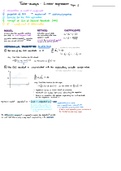Summary
Econometrics Summary_All Lecture Topics (MT and LT)
- Institution
- London School Of Economics (LSE)
This summary contains key takeaways, main ideas and concepts, formulas from each of the topics covered throughout the year (both Michaelmas and Lent Terms). The following summary gives an overall view of the MG205 Econometrics course, as well as a solid base for exam revisions allowing you to conso...
[Show more]




